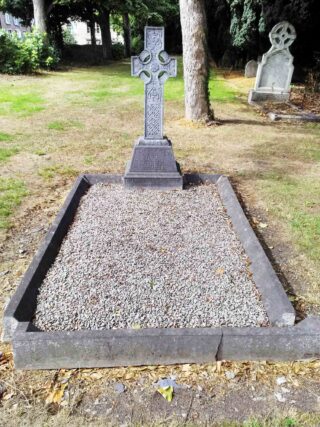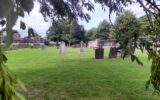
As the storm clouds of war once again appeared on the horizon, Charles Blackburne returned to England and enlisted in the British army. He was appointed Captain of the 5th Dragoons (from the special reserve) on the 5th August 1914.
It was not long afterwards that Captain Blackburne was posted overseas and saw action in the Ypres sector during 1915. This area was under continuous bombardment from the German artillery. The line became untenable and Captain Blackburne regrouped his men and re – occupied the vacant front line positions. He achieved this under devastating shellfire. Captain Blackburne was wounded during this dash to hold the position but remained on duty rallying his troops and urging them to stand fast. On May 14th they marched near the town of Ypres and on May 15th Captain Blackburne was admitted to hospital. For this heroic action he received the Brevet of Major on June 3rd 1915.[3]
After a period of rest and recuperation he was transferred to Dublin and took up a position on the headquarters staff in late 1915. Living in Dublin with his family was a huge change from Africa. The war also seemed distant as life in Dublin seemed to be endless paperwork and social outings. However this changed dramatically with the Rising of Easter 1916. Captain Blackburne was stationed at the Royal Hospital Kilmainham. During this difficult and turbulent period he was once again noted for his ability and steadfastness in combat. After the flames of Rebellion were extinguished, he was promoted to the rank of Brigadier Major on April 28th 1916 and then was appointed a General staff officer 2nd grade. Two years later while still resident in Ireland he was promoted to a grade 1 staff officer on April 19th 1918.
On October 10th 1918 Charles Blackburne booked passage from Kingstown (now Dun Laoghaire) to Holyhead on the Royal Mail Steamer ‘The SS Leinster’. Accompanying him on the journey were his wife and two children. The R.M.S Leinster was built in 1897, one of a quartet of identical cross channel steamers. These vessels had been named after the four provinces of Ireland, Ulster, Munster, Leinster and Connaught. They had been built at the Cummel Laird shipyards in Birkenhead in England. The Leinster’s tonnage had been registered at 2646 tons. Because of wartime she had been camouflaged and armed with one 12-pound gun and two signalling guns. As Captain Blackburne and his family boarded the ship they noticed the large amount of passengers and crew many of which were soldiers returning from leave in Ireland. The ship was leaving port with a full complement of 771 persons on board. As the ship sailed out to the Irish channel, the thoughts of U Boat activity were present in the minds of all on board. This stretch of water was notorious for submarine activity. The ship was 16 miles out to sea when a huge explosion shook the vessel.

The twenty-seven year old German commander of UB123 Robert Ramm had sighted the ship. He had released three torpedoes. The first had missed the target. The second had struck the port bow.
Smoke filled the cabins as flames shot through the air and acrid black smoke bellowed from below decks. Panic and confusion filled the passengers and crew. Captain Birch of the Leinster tried to manoeuvre the ship in order to return to port. It was then that the third torpedo struck the vessel in the area of the engine room. The final deathblow had struck the ship and it was now beyond saving. The devastation of the Leinster had taken place in under ten minutes. As the ship sank beneath the waves, 501 of its 771 passengers and crew were lost. Among the casualties were Captain Blackburne and his two children. His wife survived.
Captain Charles Blackburne’s body was returned to the Royal Hospital Kilmainham to be buried along with his son, Peter. On Monday 21st October 1918, the autumn sunshine glistened through the stained glass windows of the hospital chapel. The service was conducted by his grace the Archbishop and very Reverend the Dean of St. Patrick’s. The chapel echoed with the voices of the choirboys of St. Patrick’s cathedral as they accompanied the music of Dr. Marchant. Blackburne’s widow stood dressed in black amidst a sea of khaki uniforms.
Their coffins were carried down the avenue and laid to rest side by side in the officer’s cemetery of the Royal Hospital. His daughter though mentioned on the headstone, is not listed at the burial service, her body lost at sea.
The inscription on the headstone reads as follows,
To the glory of God and the beloved memory of Lt. Col Charles Blackburne D.S.O, 5TH Dragoon guards, born 20th May 1876, and of Charles Bertram (Peter) his son born 3rd September 1911 who are both buried here. Also of Beatrice Audrey his daughter, born 24th June 1907. All of whom lost their lives in the sinking of H.M.S Leinster by a German submarine 10th October 1918
‘When thou passest through the waters I will be with thee’
The sinking of the Leinster took place 33 days before the armistice with Germany was signed bringing an end to the Great War.
The cold soil of Ireland is far removed from that of the warm African plains. Captain Blackburne had answered his country’s call and his family had followed him across the world. Charles Blackburne was forty-two years old, his son Peter seven and his daughter Beatrice eleven when they were killed. It is said that as one faces peril the episodes of one’s life pass before one’s eyes. As Charles Blackburne slipped beneath the waves perhaps the thoughts and memories of a life filled with adventure, love, romance and laughter passed before him.
Today, dedicated staff of the Office of Public Works maintain the Royal Hospital Kilmainham, it’s grounds and cemeteries and tours are ongoing throughout the year.
[1] London Gazette, 29 July 1902
[2] W.O 108/161
[3] W.O 95/1109
About the Author
Paul O’Brien MA, a military historian and author, works for the Office of Public Works and is currently based at the Royal Hospital, Kilmainham. The author of fifteen books, he has written extensively on the 1916 Rising, the British Army in Ireland and a number of local histories. He lives in Santry, Dublin with his wife, daughter and two cats. Stay up to date with the author at: paulobrienauthor.ie


